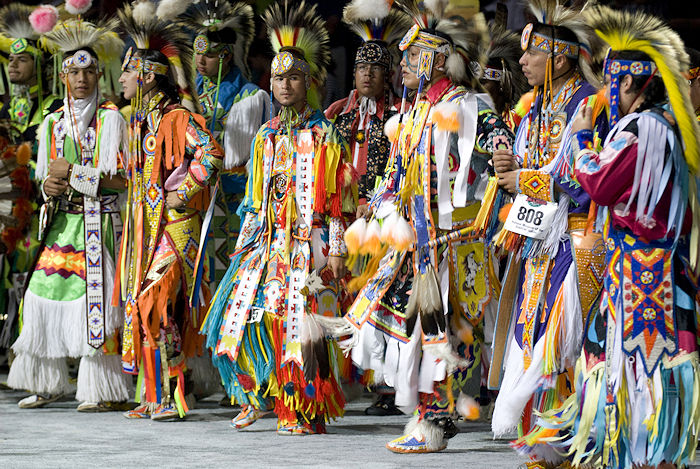Much has been written about the Grass Dance. Borrowed from the Omaha tribe, perhaps in the 1860s, this dance is very popular. Dancer’s outfits feature a good deal of colorful fringe, replacing the grasses dancers originally tucked into their belts.

Grass Dancers – Photo courtesy of Wikimedia
Many dancers wear the hair roach, the crow-belt, and the eagle-bone whistle—originally emblems for the Omaha society.
There are several stories behind the origins of the grass dance.
The original creator of the grass dance and the purpose of the dance is widely contested. Sources attribute possible origins to the Omaha, Pawnee, Ponca, Dakota, or Winnebago tribes. While the specific tribe of origin is unknown for sure, it is generally accepted as a Northern Plains dance that was used by warrior societies.
One story says that a medicine man told a handicapped boy to seek inspiration in the prairie. There he observed the swaying of the grass and received a vision of himself dancing the same style as the grass. When he shared this vision with his village, the use of his legs was returned to him and he performed the first grass dance.
When tribes lived on uncultivated prairies, the grass grew tall, which interfered with the dance steps. Before a community celebration, advance scouts or “grass dancers” would bless the dance ground and stomp down the grass.
The grass dance is a fast paced dance consisting of sweeping motions and symmetry.
It is generally faster than Northern Traditional or Straight style dancing, but not as fast as a Fancy dance.
The basic step of the Grass Dance involves the ball of one foot being tapped on one beat and placed down flatly with the next, repeating the action on the opposite foot without missing a beat. Each time the foot is placed flatly on the ground, the weight is shifted to that foot.
Dancers should keep their heads moving either up or down with the beat of the drum, nodding quickly, several times to each beat, or moving from side to side. The purpose of this action is to keep the roach crest feathers spinning. To keep the feathers moving constantly is the sign of a good dancer.
Whatever a Grass Dancer does on one side of his body, he must repeat on the other side of his body to keep the symmetry and illusion of grass swaying in the wind.
Although the Grass Dance is a freestyle type of dancing, dancers must follow the changing beat of the drum and stop when the music does, with both feet on the ground.
The competition is divided into four categories: men, teen, junior, and little boys.

